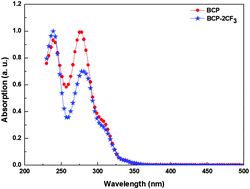Trifluoromethyl-functionalized bathocuproine for polymer solar cells†
Abstract
A novel bathocuproine (BCP) derivative 4,7-bis(3,5-bis(trifluoromethyl)phenyl)-2,9-dimethyl-1,10-phenanthroline (BCP-2CF3) was synthesized and investigated as a candidate for exciton blocking layers (EBLs) in organic solar cells. The impacts of BCP-2CF3 and BCP on the performance of photovoltaic devices were studied for bulk-heterojunction (BHJ) devices with a blend of poly[N-9′′-hepta-decanyl-2,7-carbazole-alt-5,5-(4′,7′-di-2-thienyl-2′,1′,3′-benzothiadiazole)] (PCDTBT) and [6,6]phenyl-C61-butyric acid methyl ester (PC61BM). In comparison with BCP, BCP-2CF3 showed a comparable improvement in the power conversion efficiency (PCE) (ca. 39%), and moreover a better thermal stability. Organic photovoltaic (OPV) devices with BCP-2CF3 withstood an annealing temperature as high as 100 °C, while those with BCP revealed a loss about 90% of the original efficiency at the same temperature. The newly designed principle for BCP-derived EBL materials opens a window for systematic enhancement of the efficiency and especially durability of organic solar cells.


 Please wait while we load your content...
Please wait while we load your content...